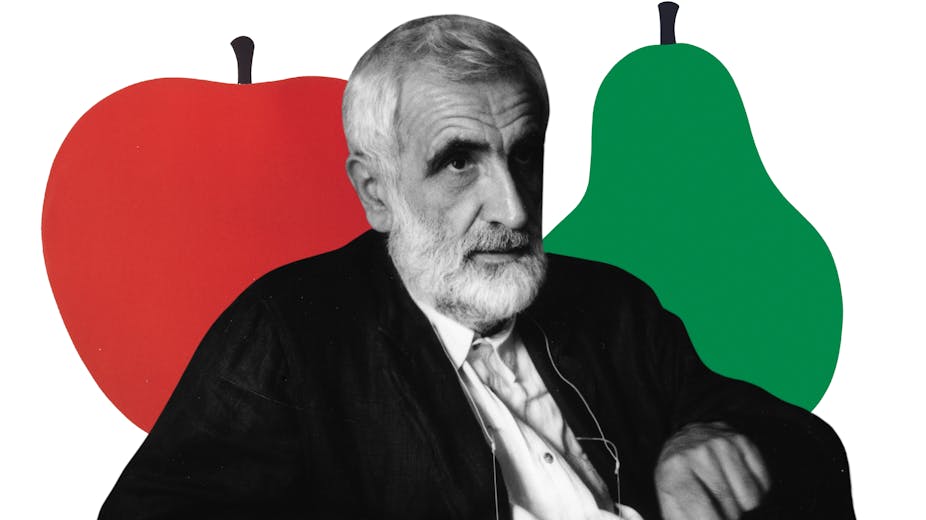The new Enzo Mari exhibition at London’s Design Museum offers a rare glimpse into the work of one of Italy’s most prominent designers and thinkers on design and aesthetics. Mari (1932-2020) was staunchly anticapitalist and remained a thorn in the glossy side of the design industry throughout his career.
Mari was born in Novara, northwest Italy, to working-class parents who moved to Milan when he was a young child. Mari was born in 1932, the year of the Decennale, Mussolini’s celebration of the first ten years of the so-called fascist revolution.
Milan emerged from the destruction of the second world war as the industrial driving force of the country. It was also the city with the highest number of private art galleries in Italy, and where the design and fashion press were based, paving the way for the city’s international position in those two industries.
The exhibition at the Design Museum is based on a show planned before Mari died in 2020 and held at the Milan Triennale, as part of planned ongoing collaboration between the two museums. It is especially important because Mari donated his archive to the city of Milan on condition that it would remain closed for 40 years. That means this is literally a once-in-a-generation opportunity to get close to Mari’s design process and see pieces from the archive before it closes until 2060.

Mari’s finished products are widely accessible because many are still in production. This includes the Formosa perpetual wall calendar (1963), the Putrella fruit bowl (1958) or the silkscreen art prints La Mela e la Pera (1963) all designed by Mari for the Milan-based design company, Danese.
What makes the Design Museum exhibition special is the access it gives to the research process behind Mari’s pieces. The show offers an opportunity to think about his entire career, including his fine arts beginnings at the Accademia di Brera, Milan’s foremost art academy, whose alumni include the architect Achille Castiglioni and designer Joe Colombo.
The vision behind the exhibition
Mari’s vision for the exhibition, as the curators note, was to display objects “without distinctions between discipline and medium”. He hoped this would mean that people could see the “continuous interconnections between his research and his work”.
The absence of clearly defined boundaries between arts, media and other disciplines is not unique to Italy or to the field of design. Yet, 20th-century Italy has a very distinguished tradition of working across arts and media, as I argue in my own research.
Mari delighted in the fluid movement between design theory and practice, between different types of design (graphic, illustration, product and furniture design) and different artistic media (painting, sculpture, writing). But he also maintained a deep appreciation for craft.

Following Marxist theory, Mari saw all work as fundamentally alienating. This was with the partial exception of work created through craft and art, which he believed came closer to the idea of “transformative work”. In Marxist terms, work becomes “transformative” when it changes the values of the commodities we produce. This is political work that affects change in the world, rather than simply producing goods.
Mari’s wooden puzzles and his illustrated books for children are a brilliant example of this. They also showcase the interest that many mid-century Italian designers had in the pedagogical application of design, and the role that design played in creative thinking.
Mari was deeply interested in the idea of play and playfulness as a fundamental stage of the creative process, but also as tools to think outside the box. The box in this case represents the constraints to our lives and thinking which a capitalist and consumerist society imposes upon us.
The concept of children’s play challenges societal and cultural norms by refocusing our attention on the power of imagination and the crucial element of creativity – the state of flow. This is the feeling when we are present and fully engaged in what we do, solely immersed in the creating process.
Mari’s politics
The exhibition opens with a quotation from Mari that frames the concept of the show and gives a clear indication of Mari’s lifelong preoccupation with design and politics: “I want to create models for a different society – for a way of producing and living differently.”
Challenging the idea that arts and culture are simply products to consume feels as pressing today as it did in postwar Italy. This was the time of the intense industrialisation and economic growth in Italy which reached its peak in the period between 1958-1963, when Mari was in his 20s and early 30s.

The Italian economic boom had its roots in the immediate postwar period and continued well in the late 1960s. It only came to a halt in the 1970s, when the international oil crisis and a decade of social and political unrest in Italy brought to the surface the ugly side of intense industrialisation fuelled by excessive consumerism.
Behind the shiny facade of Italy’s modernisation were poor working conditions, even poorer housing for the working class and intensely debated issues such as the social divide and access to education.
Mari was acutely aware of these issues. He used his design practice and his thinking about the theory of design as a vehicle to help people rethink their way of producing, consuming and ultimately living their lives. In an old video interview with the exhibition’s curator Hans Ulrich Obrist, which is on show in the museum, Mari talks openly about the need to produce culture, not to simply observe it.
This social and political engagement – the idea of design as a political act – underpins Mari’s lifelong critique of mass consumerism. And it still resonates strongly in our time of climate emergency, social action and economic uncertainty.

Looking for something good? Cut through the noise with a carefully curated selection of the latest releases, live events and exhibitions, straight to your inbox every fortnight, on Fridays. Sign up here.

